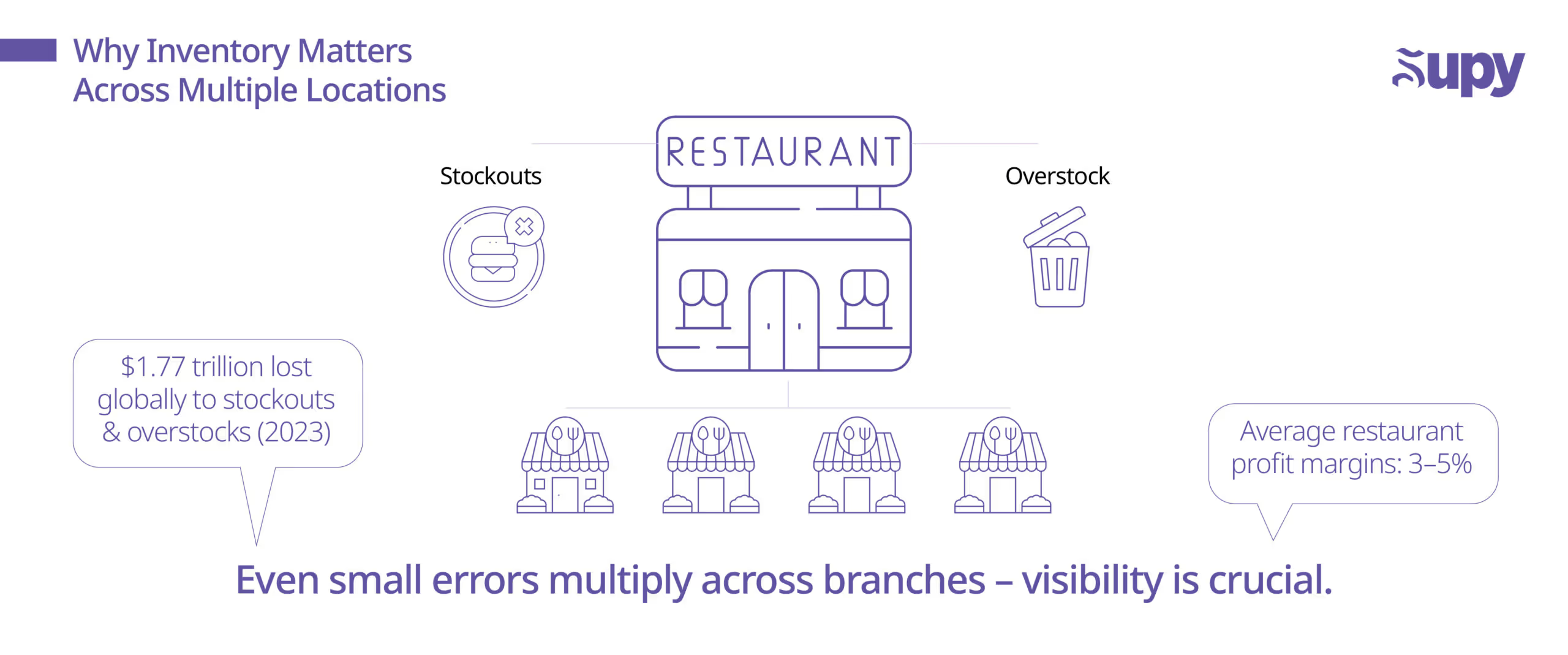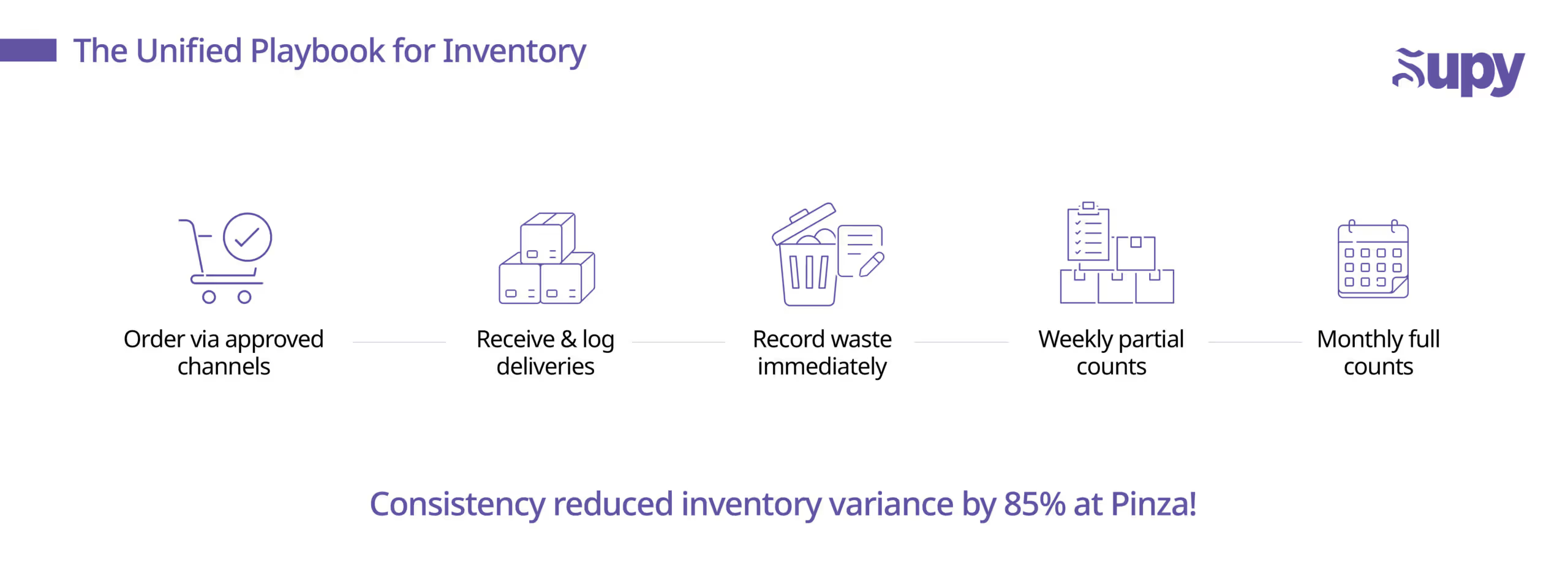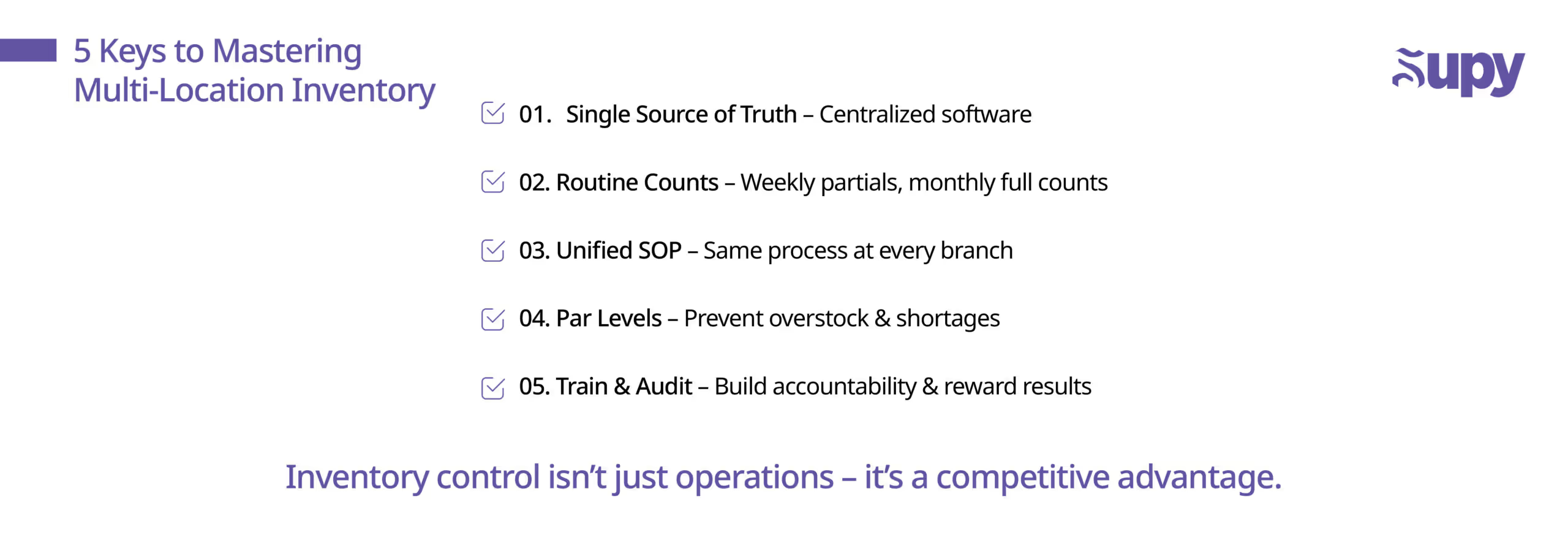Mastering Multi-Location Restaurant Inventory Management

Managing inventory in a single restaurant is challenging enough, but doing it across dozens of locations can feel like a high-wire act. For operations directors overseeing 10, 20, or 50 branches, inventory mistakes get magnified – one missed stock count or ordering error in each outlet quickly adds up to significant waste and cost. In an era of rising food prices and razor-thin margins, getting a handle on multi-location inventory is no longer optional; it’s an essential strategic priority.Every extra bag of produce that spoils or each stockout of a menu item not only hurts profits, but also damages customer trust. A recent industry report found that 87% of restaurateurs saw food costs rise in 2024, with 82% expecting further increases in 2025. With average restaurant profit margins only around 3–5% 3 , there is zero room for error. The good news is that with the right systems and practices, even complex restaurant groups can keep inventory tightly controlled across all their locations.

Standardize Inventory Processes Across Branches

The foundation of effective multi-unit inventory management is getting every branch on the same page. Variations in how each location orders, counts stock, or records waste will inevitably lead to inconsistency and shrinkage. Start by establishing a clear Standard Operating Procedure (SOP) for inventory tasks, and train all store managers to follow it rigorously. This means daily actions like ordering ingredients through approved channels, logging every invoice and delivery, and recording any wastage immediately. It also includes weekly and monthly routines – for example, doing partial stock counts on key items each week and a full inventory count at month-end at every outlet. When every branch follows an identical playbook, it becomes much easier to spot anomalies and enforce accountability.Consistency was a key lesson for Pinza!, a regional pizza chain. By rolling out one standardized inventory app and process to all their stores, they reduced inventory variance by 85%, virtually eliminating the discrepancies that had been plaguing their food cost. The takeaway is clear: document your processes and make sure each location from the flagship to the furthest franchise is sticking to them daily.
Centralize and Digitize Your Inventory Tracking

Trying to manage multi-branch inventory with pen-and-paper or isolated spreadsheets is a recipe for disaster. Without a centralized inventory management system, head office lacks real-time visibility into what each location has on hand. This often leads to over-ordering at some outlets and stockouts at others, since there’s no single source of truth for inventory levels. To avoid these pitfalls, invest in a modern inventory management platform that all locations use.A good system will let branch managers log all key data – deliveries, transfers, counts, wastage – which headquarters can monitor instantly. This real-time tracking enables smarter purchasing: if one store has a surplus of an item and another is running low, you can transfer stock or adjust orders proactively. One global study showed that inventory stockouts and overstocks were expected to cost businesses an astounding $1.77 trillion in 2023 – largely due to poor visibility. Cloud-based tools eliminate those blind spots by consolidating inventory data across your whole chain.Digital platforms also help catch errors. For instance, if a cashier enters an invoice twice or forgets to log a delivery, centralized software with built-in discrepancy alerts will flag it. By automating data capture (e.g. via barcode scanning or POS integration) you reduce manual mistakes and ensure that every sale or waste event updates the stock count immediately. The result is a live, accurate picture of inventory everywhere, instead of finding out at the end of the month that several cases of goods “went missing.”
Optimize Par Levels and Ordering Frequency
Multi-outlet operators must strike a careful balance: you never want to 86 a popular menu item due to stockout, but excess stock means higher spoilage. The solution is to set par levels (ideal stock quantities) and reorder points for each product at each location – and stick to them. Your SOP should define how to calculate pars based on usage rates and lead times, and your inventory system can then alert managers when an item falls below its minimum.For example, if the par for chicken breast at a branch is 50 kg and the min is 20 kg, the software can notify the chef or auto-generate a purchase order when inventory hits that threshold. This prevents branch staff from ordering “by gut feel” (often resulting in either overstock or shortages). It’s also wise to review these levels quarterly, because as menu items change or sales trends shift, so should your par levels.Another tip: synchronize ordering schedules across locations where possible. Many restaurant groups place orders daily, but consolidating some purchases or aligning delivery days can yield bulk discounts and reduce admin work. Ensure each order is approved centrally or at least reviewed – your branch managers should not be acting as free agents with purchasing. Also, make sure they check each delivery against the orderandloganydiscrepanciesimmediately. Catching a supplier shorting a delivery or sending sub par goods is only possible if receiving is done carefully and documented in the system for HQ to see.
Regular Stock Counts and Variance Checks
There’s no escaping it: physical stock counts are laborious, but they are absolutely vital in a multi-location operation. Without regular counts, small losses due to waste, theft, or counting errors can snowball unchecked. The best practice is to conduct weekly cycle counts of high-value or fast-moving items at each branch, and a complete inventory count monthly. This consistent cadence acts as a safety net – issues can be caught within a week or two rather than months later.To make counts efficient and accurate, arm your teams with tools and training. Use count sheets or a mobile app grouped by storage areas (dry, cooler, freezer, bar) so staff can tally systematically and not miss anything. As the Supy branch SOP suggests, it helps to assign each item to a specific storage area in the system, so counters can filter and input data location-by-location. Two-person counting teams (one counts, one records) add accountability and reduce mistakes like “double counting” or misreading labels. And importantly, compare the counted quantities to the book quantities immediately after each count. Your inventory software or even a simple variance report in Excel will show any differences. Investigate significant variances right away – if one outlet is consistently missing a lot of a costly ingredient, find out why. Maybe staff are over-portioning, or maybe something worse. Either way, you can’t fix what you don’t measure.By acting on variances, you close the loop on inventory control. Headquarters might require branch managers to explain any weekly variances above, say, 1% of food sales. One Middle East cafe chain using this approach found that just the act of measuring and reviewing variance publicly among managers spurred more careful handling of inventory. Over a few months, variance dropped from 4% of cost to under 1% chain-wide simply because everyone knew the numbers were being watched.
Empower Teams with Training and Oversight
Even the best systems and processes won’t work if your people aren’t bought in. Training is paramount – not just initial training on software, but ongoing coaching on why these inventory tasks matter. Make sure every branch manager (and their key kitchen staff) understands that inventory management is part of their performance metrics. Share data to motivate them: for instance, show each store’s monthly waste as a percentage of purchases, and celebrate the ones with improvements or consistently low variance.It’s also crucial to set proper user roles and permissions in your systems. You don’t want every junior employee editing inventory records. Limit access so that only authorized managers can, say, finalize a stock count or approve a wastage entry. This controlled access reduces accidental (or intentional) missteps and keeps data integrity high. Meanwhile, district managers or the head of operations should be regularly auditing inventory data. Use your platform’s dashboard to scan key metrics – like current stock value, days on hand, variance – per location. If something looks off, dive in and address it quickly. Anomalies in one branch often indicate either a process failure or a personnel issue that needs attention.Finally, foster a culture of ownership. When cooks and shift leads treat the food on the shelf like it’s their own money, wastage drops. Encourage simple habits: chefs should rotate stock FIFO (first-in, first-out) to avoid expiration, bartenders should measure pours, and everyone should report issues (like a fridge outage or a bad batch of produce) immediately. In short, make inventory control everyone’s job, not just an HQ mandate.
Actionable Takeaways

- Single Source of Truth: Use one centralized system for inventory across all branches to gain real- time visibility and prevent stock discrepancies.
- Routine Counts: Conduct weekly partial counts and monthly full counts at every location, and act on variance reports to catch issues early.
- Unified SOP: Ensure every branch follows the same inventory SOP for ordering, receiving, counting, and wastage logging – consistency drives accountability.
- Par Levels: Set and regularly update par levels for each item per location to guide ordering and avoid overstock or stockouts.
- Train and Audit: Continuously train staff on processes and audit branch data. Reward branches that control inventory well to reinforce good habits.
Inventory management doesn’t have to be a juggling act, even if you have dozens of locations. With the right approach, you can turn it into a competitive advantage for your restaurant group.To see how technology can simplify multi-location inventory control, book a free Supy demo and read our blog “Restaurant Inventory Management Best Practices: 2025 Guide for Managers” for more insights.







